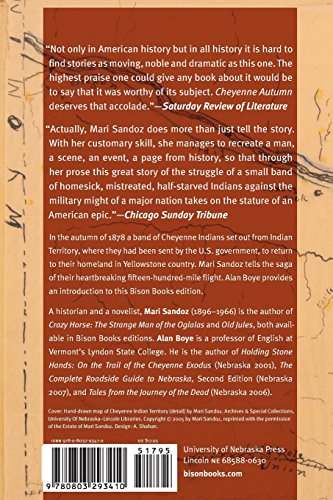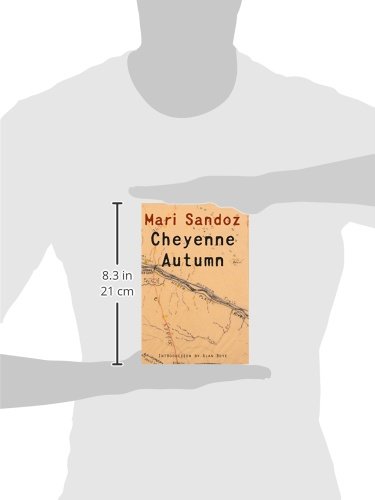



Full description not available
J**N
Fine addition to my library
Enjoyed immensely! Very well written, Both ejoyable and informative!!
B**D
Good!
An accurate, though fictional account of the US government's treatment of the Northern Cheyenne people as they were forced off their ancestral lands and forced to Oklahoma where they were abused until they could no longer take it.
T**E
Riveting
Very well written. Writer held interviews with Cheyenne’s and did a lot of research. She lived in the area as a child. Heart breaking story.
R**D
narrative history that is vivid, deep, and literary
Ever since I saw the film Little Big Man as a child, I have wanted to read more about the Cheyenne. It was for this reason, with very high expectations, that I bought this book, now as an adult fascinated by history. It was completely satisfying, with clues about their culture, their fate, their system of values, and their behavior. The best part is: I feel very hungry for more.The story begins a few years after the battle of the Little Bighorn, when the Cheyenne have been taken to a reservation far to the south. They are starving, dying of malaria in a foreign climate, and bitterly disillusioned. On the strength of a promise that they could always leave - which was explicitly denied them when they tried to claim the right - they set out secretly to return to their homeland. The result is a brutal journey that essentially marks the end of their way of life, though some survived to live on reservations. As vengeance, they kill on their way, taking what they need, waging war in accordance with their codes, and suffering mightily in their vain search for freedom and their past way. It is what it is, the final clash with the white man's culture and not sugar-coated or romanticized in the slightest.This is a very difficult book, in large part because the language is masterfully crafted to reflect the rhythm and manner of Cheyenne speech. It must be read slowly and carefully, almost out loud and perhaps multiple times, like the best Nabokov novel, for narrative texture and aesthetic. There are also very many characters who appear, disappear, and then reappear, which is hard to keep straight. But they are brilliantly drawn, subtle yet consistent, and representatives of pieces of a vanishing culture.According to the introduction, Sandoz was scrupulous in her desire for accuracy, though many of the supporting documents - some the only copies in existence - were destroyed in fire. It is horribly bleak.
A**R
It was Little Finger Nail who spoke at a meeting of the Cheyenne while they were still at the reservation in Oklahoma with these
This is the second time that I've read Cheyenne Autumn.First time was back in the 70's following my reading of Dee Brown's Bury My Heartat Wounded Knee.The story of the expulsion of the Northern Cheyenne to Oklahoma & their subsequent efforts to return to their homeland in Montana is surely nothing short of heroic.Certainly the Cheyenne engaged in warfare against farmers etc but in their eyes it was a rite of passage to return to the land that they had called home.The internment in Fort Robinson with little food \supplies & the subsequent escapeand battle certainly brings out many emotions.I am visiting the U.S. soon and during our trip I intend to visit Fort Robinson& the Mari Sandoz Cultural Centre in Chadron NE. Before we head west ,part of our time will be spent in New York where a visit to the Museum of Natural History is planned .One of the many Native American exhibits there is the Ledger Book of Little Finger Nail ,Cheyenne Warrior & artist.Little Finger Nail had the ledger on him when he was killed in the ""Battle of the Pit"", some after the Cheyenne escaped from Fort Robinson.It was Little Finger Nail who spoke at a meeting of the Cheyenne while they were still at the reservation in Oklahoma with these brilliant words.""If we die here & go to the burial rocks, no one will speak our names. So now we go north, and if we die in battle along the way, our names will be remembered by all the people. They will tell the story and say , this is the place. How true.
C**E
Requires perseverance...worth it in the end
So much has been written about the Lakota and the many compelling leaders of this tribe: Sitting Bull, Crazy Horse, Red Cloud, Spotted Tail, Gall, etc. Noteworthy here is the extensive work of Joseph Marshall III, both his nonfiction and fiction. However, so little has been written about their allies, the Northern Cheyenne and the compelling leaders of that tribe: Dull Knife, Little Wolf, etc. Cheyenne Autumn is a fictionalized version of the flight of the Northern Cheyenne fleeing Indian Territory in the South to their home in Yellowstone Country. What prevents me from giving this book a 5 star rating is the writing and narrative style of Mari Sandoz. At times choppy and lacking in fluidity, at times repetitive, at times seeming to lose the thread of the story, it required some measure of perseverance to complete this book. Until another author takes on this epic tale, this is what we have.
C**S
Cheyenne Autumn: An American Epic that chronicles mans inhumanity to man.
Cheyenne Autumn was published half a century ago, yet it is as apt to the Native American Story today as it was when published and as apt to the19th century when the horrors actually occurred. It is the story of a People's will to survive, to live where they belong, and to abide in their ancient culture. The Cheyenne Nation's catastrophic clash with the arrogance of the European inspired attitude that "everything I see I own" and the New Americans' utter contempt for those who had inhabited this land for millennia is heart rending. Cheyenne Autumn is the heroic true story of Dull Knife's leadership; the heroism of others like him, and the treachery and evil that men visit upon different cultures in the name of orders from distant governments. Murder of innocent men, women, children, and babies happens when otherwise good people become mindless killers in the maelstrom of carrying out orders, fear of the unknown, rage, self contempt, guilt and devolution of good order into savage murdering gang mentality.
M**S
A very full account of the injustice suffered by the First Nation Tribes of N America
A full account which does'nt flinch from telling it like it was - and it is an antidote to all those 1950's films in which the"Indians" were always the bad boys ! The real villains were of course the Govt. and the Rail Companies, expediency ruled !!
G**3
Excellent
A fantastic novel written by a self taught Swiss immigrant to America, who provides an insightful tale of misuse of First Nation Peoples by The then US Government. It seems from the narrative that little has changed.
P**N
Very confusing as there were seldom any references to actual ...
Very confusing as there were seldom any references to actual dates.As a research tool I have to be able to tie actual happenings to a time in history otherwise its just another story.
S**R
Five Stars
Read it and know why I rate it thus
A**N
Five Stars
Excellent book arrived on time, very pleased.
Trustpilot
1 day ago
2 weeks ago